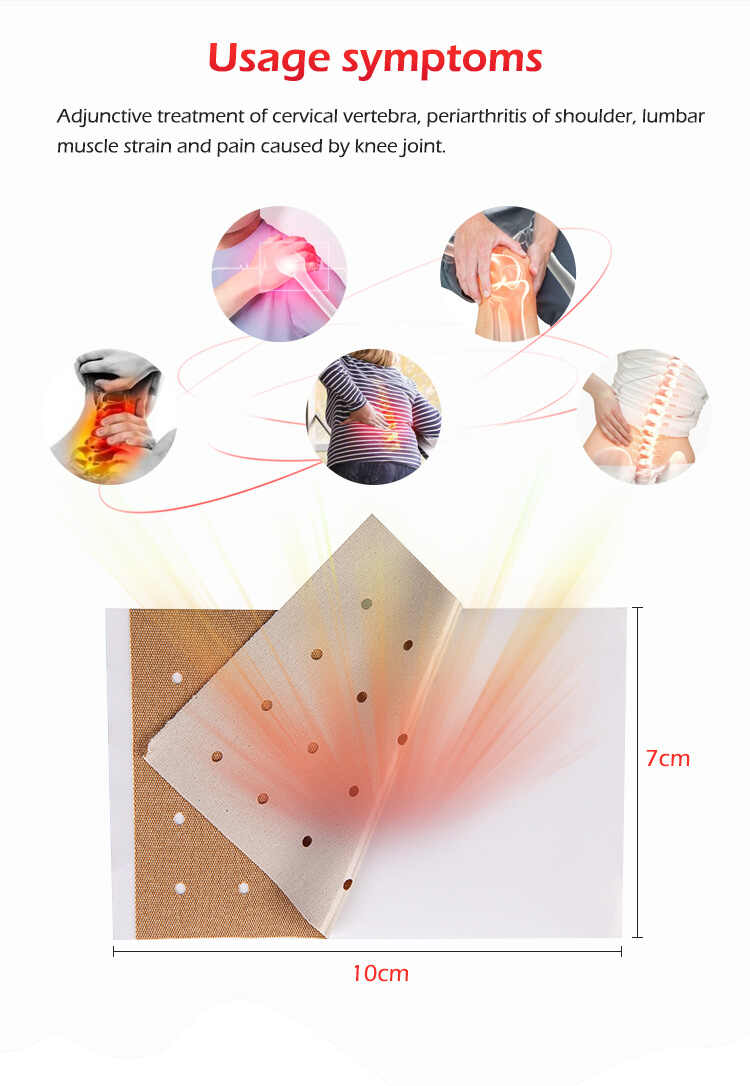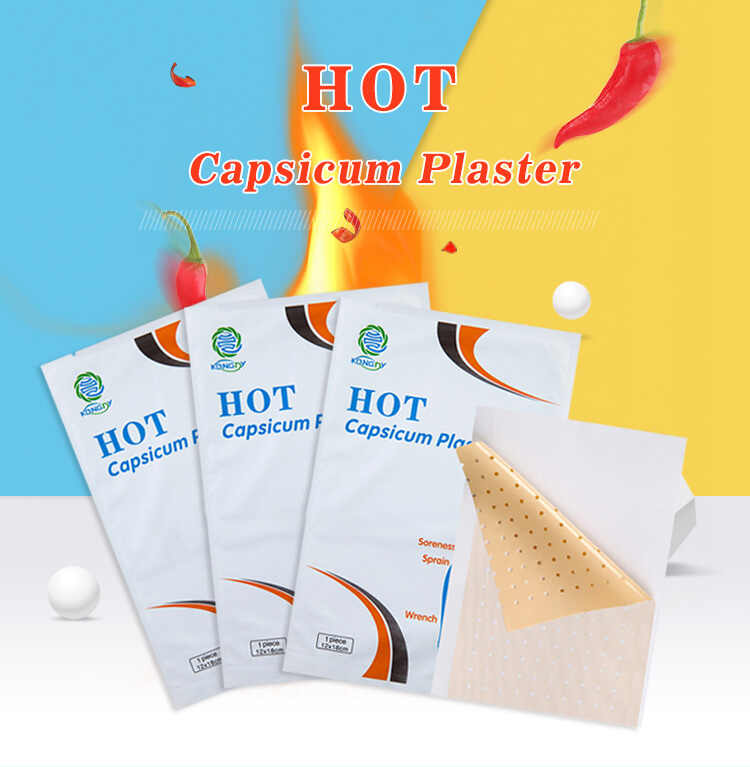Are Capsicum Pain Relief Plasters Safe for Long-Term Use? A Comprehensive Guide for Brands and Consumers
As demand for natural pain management grows, Capsicum Pain Relief Plasters are becoming increasingly popular among consumers and businesses alike. Derived from chili pepper extract (capsaicin), these transdermal patches deliver targeted warmth and relief for conditions like arthritis, muscle soreness, and back pain. However, many ask a critical question before long-term application or investment: Are capsicum pain relief plasters safe for long-term use?
This article provides an evidence-based, SEO-optimized exploration of the long-term safety of these plasters. Whether you're a consumer or a brand working with a Capsicum Pain Relief Plaster Manufacturer, OEM, or Private Label Supplier, this guide helps you make informed decisions.

Table of Contents
Introduction to Capsicum Pain Relief Plasters
How Capsicum Pain Relief Plasters Work
Safety Profile of Capsaicin for Long-Term Use
Common Side Effects and Risk Factors
Long-Term Use: What Research Says
Role of the Manufacturer in Ensuring Product Safety
How OEM and Private Label Solutions Address Safety
Tips for Safe Long-Term Use
Conclusion
Related Questions and Answers
1. Introduction to Capsicum Pain Relief Plasters
Capsicum (capsaicin) is a compound found in chili peppers known for its heat-producing and analgesic properties. It is widely used in Capsicum Pain Relief Plasters to manage chronic and acute pain. With rising consumer interest in drug-free pain relief options, Capsicum Pain Relief Plaster OEM and Private Label Capsicum Pain Relief Plaster partnerships are thriving. But as use becomes more widespread, understanding long-term safety becomes paramount.
2. How Capsicum Pain Relief Plasters Work
Capsicum patches work by:
Activating TRPV1 receptors in the skin, which temporarily desensitize pain nerves
Increasing local blood circulation
Providing a warming sensation that relaxes muscles and joints
The patches are applied directly to the skin over affected areas and are typically worn for 8–12 hours per application. High-quality options from a reliable Capsicum Pain Relief Plaster Manufacturer or Capsicum Pain Relief Plaster Supplier come with detailed usage guidelines and safety assurances.
3. Safety Profile of Capsaicin for Long-Term Use
Clinical Evidence
According to multiple clinical studies, capsaicin is generally safe for prolonged use when applied topically:
A 2011 study published in Drugs found that long-term use of capsaicin patches in chronic neuropathic pain patients showed no significant systemic side effects.
A British Journal of Clinical Pharmacology review concluded that repeated capsaicin application may lead to reduced pain sensation over time, enhancing therapeutic value.
Regulatory Status
Capsaicin is approved by regulatory bodies like:
FDA (U.S.) – for use in over-the-counter topical pain relievers
EMA (EU) – for neuropathic and musculoskeletal pain
TGA (Australia) – for natural pain management products
This recognition adds credibility to formulations offered by certified Capsicum Pain Relief Plaster OEM partners and Private Label Suppliers.
4. Common Side Effects and Risk Factors
Despite its safety, prolonged or improper use of capsaicin patches can pose risks:
| Side Effect | Description |
|---|---|
| Skin Irritation | Redness, burning, or itching may occur during initial uses. |
| Allergic Reaction | Rare but possible in sensitive individuals. |
| Desensitization | Long-term use may dull local skin sensitivity. |
| Contact Dermatitis | More likely with low-quality or counterfeit products. |
5. Long-Term Use: What Research Says
Neurological Impact
Capsaicin causes a temporary depletion of “Substance P,” a chemical that transmits pain. Long-term use has shown continued effectiveness in reducing chronic pain symptoms without causing nerve damage, as per a Mayo Clinic review.
Skin Health
Studies show that consistent use on healthy skin does not lead to long-term tissue damage. Still, it's essential to rotate application sites and allow skin to recover between uses.
Tolerance and Efficacy
There is no evidence that the body builds tolerance to topical capsaicin over time, making it suitable for continuous use in chronic conditions like:
Osteoarthritis
Rheumatoid arthritis
Chronic back pain
Neuropathic pain
6. Role of the Manufacturer in Ensuring Product Safety
The safety of long-term use is closely tied to the Capsicum Pain Relief Plaster Manufacturer:
Ingredient Purity: Use of pharmaceutical-grade capsaicin
Patch Quality: Breathable, hypoallergenic materials
Quality Control: GMP and ISO-certified production
Testing: Clinical safety and dermatological tests
A reputable Capsicum Pain Relief Plaster OEM ensures these elements are integrated into every Custom Capsicum Pain Relief Plaster.
7. How OEM and Private Label Solutions Address Safety
Whether you're launching a new brand or expanding an existing line, choosing between OEM and Private Label impacts your product’s safety profile.
OEM Solutions
Custom formulations tailored to sensitivity or long-term use
Control over capsaicin dosage and skin compatibility
Ideal for brands targeting chronic pain management markets
Private Label Solutions
Pre-tested, market-proven products
Fast-track to compliance and safety validation
Lower investment but limited customization
By choosing an experienced Capsicum Pain Relief Plaster Supplier, businesses can ensure safety, efficacy, and consumer trust—especially for long-term use applications.
8. Tips for Safe Long-Term Use
Here are best practices to follow whether you’re a consumer or formulating with a Capsicum Pain Relief Plaster OEM:
For Consumers:
Follow usage instructions precisely
Do not apply to broken or irritated skin
Rotate application areas to avoid skin stress
Discontinue use if you notice severe irritation or allergic reaction
For Brands:
Work with a certified Capsicum Pain Relief Plaster Manufacturer
Offer clear product labeling and usage guidance
Educate customers on safe long-term use via inserts or QR codes
Opt for hypoallergenic adhesive bases in your formulation
9. Conclusion
So, are Capsicum Pain Relief Plasters safe for long-term use? The answer is a resounding yes, provided the product is formulated correctly, used as directed, and sourced from a trusted Capsicum Pain Relief Plaster Manufacturer, OEM, or Private Label Supplier. With consistent quality, regulatory compliance, and proper usage, capsicum plasters can be a reliable, non-invasive tool for ongoing pain management.
As the market grows, businesses should prioritize safety in both product development and branding. Partnering with the right Capsicum Pain Relief Plaster Supplier ensures your customers receive products that are not only effective but also safe for extended use.
10. Related Questions and Answers
Q1: Can I use capsicum pain relief plasters every day?
A: Yes, daily use is possible, but it’s best to follow product guidelines and rotate application sites.
Q2: Do capsicum patches have long-term side effects?
A: When used correctly, most users experience no long-term side effects beyond mild skin irritation.
Q3: Is it safe to develop a Custom Capsicum Pain Relief Plaster for chronic conditions?
A: Yes, as long as the formulation is clinically tested and developed through a qualified Capsicum Pain Relief Plaster OEM.
Q4: How do I ensure my private label capsicum plaster is safe?
A: Choose a Private Label Capsicum Pain Relief Plaster from a reputable manufacturer with proven compliance and dermatological testing.
Q5: What should I look for in a Capsicum Pain Relief Plaster Supplier for long-term use products?
A: Look for GMP certification, proven clinical safety data, ingredient traceability, and customer support for compliance documentation.
Q6: Are natural formulations safer for long-term use?
A: Natural does not always mean safe—clinical validation is essential. Partner with a Capsicum Pain Relief Plaster Manufacturer that offers both natural and tested ingredients.






